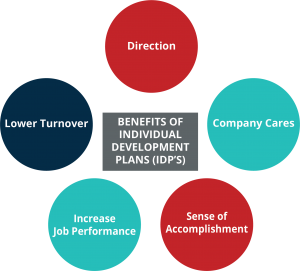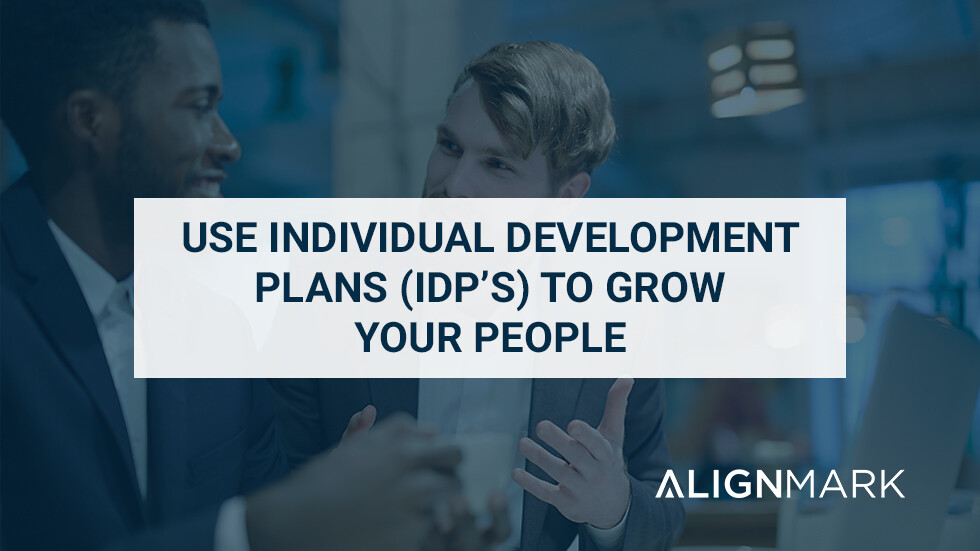Table of Contents
Use Individual Development Plans (IDP’s) to grow your people
The most important asset of any company normally is their people. People may come in with the right credentials and do a tremendous job but there is always room for improvement. Without consistent continuous improvement it is easy to see lower productivity, decreased interest in the business and potentially even turnover. None of these things are good for the business and many times are preventable through an ongoing process of investing in and building the skills and abilities of your people. Individual Development Plans are a great way to development and maintain a consistent methodology of on-the-job improvement.
The process of creating and implementing individual development plans within an organization is simple. Many companies don’t engage in this practice because they think it is too difficult or takes too much time. In fact, the opposite is true. The return on investment for engaging in this activity is tremendous, and the resource costs are just not that great.
What is an Individual Development Plan (IDP)?
The key-word here is Individual. An INDIVIDUAL Development Plan consists of a well thought-out, actionable plan that is created specifically for the individual who will be using it. They typically start with an assessment like 360 degree feedback that will provide a solid benchmark that the individual can use to understand his/her strengths & weaknesses as well as areas for improvement. This benchmark is important because if you don’t know where you are, it is nearly impossible to know where you are going. Once you have the benchmark, a plan is created to specifically work on the areas identified by the assessment. When done correctly, IDP’s become living documents whereby as improvements are made and new actionable areas are identified so that the employee can continue to work on themselves.
How do Individual Development Plans work?
1. Benchmarking occurs to find out what the starting point should be.
2. A plan that includes a timeline is put together to work on areas identified in the benchmarking.
3. A Coach or a Mentor is assigned to the employee for accountability, encouragement, and a sounding board. Keep in mind that the coach/mentor can be internal to the organization or external, and does not only have to be a single individual.
4. The process of benchmarking occurs again to identify if progress is being made. We know that what gets measured gets paid attention to. If an individual is left on their own to work on a plan with no accountability or measurement that the plan is much less likely to be executed.
5. Plan refinements occur throughout the year as progress is being made.
What are the benefits?

1. Direction
It is always good to know where one’s strengths and weaknesses lie. It is even better to know how to improve the areas you need to use on the job to do a better job. Having a plan of action to get better is a great way to provide direction to an employee.
2. It shows employees that their company cares
These new generations want to feel like their company cares about them. In fact, for many of them they appreciate that feeling more than they do their paycheck. By spending the time on creating an individual plan, it shows you are willing to invest time and money into their improvement.
3. Sense of accomplishment
Most people are list checkers. To have a plan for improvement and to accomplish the tasks necessary to improve, you get a sense of accomplishment. Normally, you just feel better knowing you did something to improve yourself – – – just like working out!
4. Increased job performance
Normally the company that invests in their employees by using tools such as Individual Development Plans see returns of tenfold when looking at job performance. It is always in a company’s best interest to improve their people and leads to measurable results such as customer satisfaction, increased revenue and so on.
5. Lower turnover
Employees who are performing are typically happier employees. If they are happy and they can work on areas that will help them perform even better, they most likely will stay longer.
Don’t fall into the trap of one-day wonder training programs. 70 percent of development should happen through on-the-job activities. Even if an employee engages in a training program to gain some foundational knowledge, the actual behavior change that will occur on the job will be done through the individual development plan.
Amazingly, many companies still believe that they can host training seminars that will fix all their problems in a day. Truly, that approach is so 1980’s! With the sophisticated research and tools that are available today, there is no reason why every employee can’t have an Individual Development Plan that is personalized to their specific needs. When done appropriately, IDP’s can change the culture of a business to one of continuous improvement and the benefits are truly outrageous.
Related Resource: Leadership Development – Big Questions Answered
Related Blog Post: How to Create an Inclusive Leadership Development Process










 Dr. Jaffee (M.A., Ph.D.) is a recognized expert in the field of assessments, and has created effective HR Solutions used by millions of people.
Dr. Jaffee (M.A., Ph.D.) is a recognized expert in the field of assessments, and has created effective HR Solutions used by millions of people.